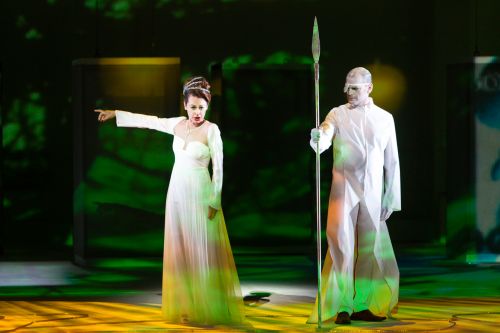Wagner: Das Rheingold, Orquesta Sinfónica del Principado de Asturias, Guillermo García Calvo (conductor), Teatro Campoamor, Oviedo, 15.09.2013 (JMI)

New Production
Direction, sets and costumes: Michal Znaniecki
Lighting: Bogumil Palewicz
Cast:
Wotan: Tómas Tómasson
Alberich: Thomas Gazheli
Loge: César Gutiérrez
Fricka: Elena Zhidkova
Fasolt: Felipe Bou
Fafner: Kurt Rydl
Erda: Birgit Remmert
Donner: David Menéndez
Froh: Jorge Rodríguez Norton
Mime: Daniel Norman
Freia: Maite Alberola
Woglinde: Eugenia Boix
Wellgunde: Sandra Ferrández
Flosshilde: Pilar Vázquez
The Ópera de Oviedo opened the season with a new production of Das Rheingold, which will be followed in coming years by the other titles in the Ring Cycle. It’s an ambitious and demanding project, one that can only be completed successfully by important opera houses. I wish them well with this great Wagnerian endeavor, but desire and enthusiasm are not enough, and the start of the tetralogy in Oviedo left something to be desired.
Oviedo’s new production is staged and directed by Michal Znaniecki, who is also responsible for the three operas to follow. His work here was disappointing, short on ideas and totally insufficient with regard to stage direction.
The sets consisted of three walls with images and texts projecting constantly on the wall at the rear of the stage, and the bombardment of videos became distracting and tiring. In addition to the projections, there were some cubes on stage, which may be more or less acceptable in the scene on the Rhine, but which are repetitive and uninteresting in others. Gods are always dressed in white, while giants and Nibelungs are puppets with big heads; Alberich and Mime also wear fins on their feet, which is more apropos to the Rhine than to the Nibelheim. Why the two giants are always dragging a cube is something that escapes me. In fact, the only positive aspect of the cubes was to facilitate the transformations of Alberich.
But the biggest problem, apart from the excessive video projections, was the lack of stage direction. I have never seen a more static Loge or less credible giants. In short, Wagner has not been well served by Znaniecki. Hopefully there’s time for him to review his ideas for the subsequent operas.
I think opera fans will agree that the orchestra is the true protagonist of any Wagner opera. Conductor and orchestra do not accompany singers as if it were bel canto: they are the real backbone of the performance, and if they are not up to the task, the opera sinks. In my opinion this is exactly what happened here with Das Rheingold . Neither Guillermo García Calvo nor the orchestra are proficient enough to do justice to this music. In January 2011, the same conductor and orchestra offered a pretty chamber music version of Tristan and Isolde; two years later, the result is poorer. The pit of the theater is too small for the large orchestra required, and, given these circumstances and the production itself, it would have been better to offer a concert version. García Calvo’s conducting lacked strength, energy, passion and solemnity, although he did have good control of the orchestra.
Wotan was the Icelandic baritone Tómas Tómasson, an adequate interpreter of the God, but with a voice that lacks great projection and falls short of his intent. German baritone Thomas Gazheli was a rather discreet Alberich, little helped by the production. His voice is good in the middle but at the top it becomes pretty tight.
The best of the cast was Elena Zhidkova as Fricka. This attractive mezzo-soprano has a beautiful dark timbre, very typical of Russian singers, and she proved that she can sing successfully in any major opera house in the world.
Loge is a key character in Das Rheingold. Unfortunately, Colombian César Gutiérrez was a shadow of what is required in the part. His voice is not outstanding in the middle, and it is thinner and badly projected at the top. On stage he seemed to be singing in a concert version, which is at least partially the responsibility of the stage director.
I found the two giants unconvincing. Felipe Bou (Fasolt) lacked authority; Kurt Rydl (Fafner) was better suited vocally, but his excessive vibrato was annoying at times. Birgit Remmert as Erda was not very moving, while Maite Alberola was a serviceable Freia, somewhat tight at the top. Daniel Norman was a discreet Mime. David Menendez was really good as Donner, with a bigger voice than Wotan, but Jorge Rodriguez Norton’s Froh was uninteresting. As for the Daughters of the Rhine, they were well served by Sandra Ferrández (Wellgunde) and Pilar Vázquez (Flosshilde), but Eugenia Boix (Woglinde) was problematic on the high notes.
Teatro Campoamor was at about 90% of capacity. The audience gave a warm reception to the artists, with the biggest cheers for Guillermo García Calvo.
José Mª Irurzun.